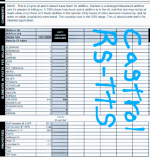You're very welcome.
You are more than welcome to share these anywhere you would like.
These numbers have been a secret long enough.
I thought about Maxima super M.
I can't recall what deterred me, is it premix only? I must check now.
Redline talks an awful lot about film strength and a super high-quality Esther base stock.

All Red Line Two-Cycle lubricants are designed to provide the great-
est protection and the maximum power from a two-cycle engine. Red
Line has many different two-cycle lubricants which vary in lubricity,
thermal stability, and ash-containing or ashless detergent type. The
greatest degree of cleanliness and lubricity is provided by our
SuperClean Two-Stroke Oil and closely followed by the Two-Stroke
Racing Oil. The SuperClean provides the best cleanliness, while the
Two-Stroke Racing Oil provides the best lubricity, which is far
superior to castor bean oil, petroleums, and other synthetics. This
lubricant provides excellent lubricity and perfect cleanliness even in
race engines operating at 15,000 rpms. But not every engine has
such demanding requirements. That is why we have many other two-
cycle lubricants to lubricate factory stock or slightly modified engines
with a less costly product without making any compromise in durabil-
ity. The main difference in our two-cycle lubricants is the temperature
stability of the basestocks used. The more thermally-stable the
basestock, the higher the cost of the lubricant, with the SuperClean
and the Two-Stroke Racing Oil product being the cleanest and most
thermally stable products on the market and the Smokeless being the
least thermally stable within our product line. However, all of these
synthetic lubricants provide better cleanliness, better protection, and
burn cleaner than any petroleum or other synthetic product available.
Many engines will not see the extreme temperatures encountered in
racing situations and can be perfectly lubricated with the Two-Stroke
AllSport™ Oil, Watercraft or Snowmobile lubricants - leaving no
piston deposits. The SuperClean Two-Stroke Oil will tolerate temper-
atures approximately 100°F greater than the Smokeless Oil and
provides perfect cleanliness in even the most extreme applications.
The graph above demonstrates the cleanliness capability of Red Line
lubricants compared to a high-quality petroleum NMMA TC-W3 lubri-
cant and other synthetics. The chart above indicates the evaporation
rate of different lubricants at 475°F. The time indicated is the time
required for the lubricant to decompose to a sticky mass capable of
sticking a two-cycle piston ring.
The NMMA TC-W3 lubricant is a baseline with which to judge the Red
Line lubricants. All Red Line lubricants provide significantly better
stability than the petroleum reference. This indicates that Red Line
lubricants will withstand the higher temperatures found in racing
two-cycle applications and will also leave more lubricant on the
cylinder walls to assist in the prevention of piston scuffing. A
competitive synthetic two-cycle (B) showed very little deposit
formation upon heating, but evaporated very quickly, with little lubri-
cant remaining at temperatures found in the ring area. Another did
not evaporate as quickly and would provide better scuff protection
than petroleum, but has relatively poor ability to prevent ring stick.
Red Line lubricants are extremely clean and data below demon-
strates that Red Line lubricants provide better scuff protection and
reduced bearing and ring wear. Red Line can provide both better
cleanliness and reduced wear.
SuperClean Two-Cycle Oil - the cleanest two-cycle lubricant
available, in fact, we have never encountered a two-cycle applica-
tion where our SuperClean Two-Cycle Oil caused deposits. It is
used in heavily modified engines which operate at temperatures
well above a stock engine and burns extremely clean, leaving little
residue in the combustion chamber or exhaust system. The scuff
protection is very good, although not quite as good as the Two-
Stroke Racing Oil.
Two-Stroke Racing Oil / Two-Stroke Kart Oil - provides cleanli-
ness which approaches the SuperClean Two-Stroke Oil, but formu-
lated with additional lubricity to keep even the highest-revving
engines perfectly lubricated. Terry Ives Industries obtained perfect
engine condition in their 100cc Yamaha KT-100 school karts after
25 hours of use. In this same type engine under 3 hours of compe-
tition at 20:1, the piston clearance increased only 0.00025 inch.
Racing castor would provide between 0.001-0.002 inch wear under
the same conditions. No ring, ring land, or cylinder wall wear was
apparent in this 3 hour engine and skirt scuffing was virtually elimi-
nated. In the Rotax 256 In-line Twin and the 125 Single the results
were equally impressive. No obvious wear could be seen and skirt
scuffing was virtually eliminated. No carbon deposits were formed
and all combustion residue was easily wiped clean. Plug life is
greatly extended. Emmick Enterprises obtained similar results in a
Yamaha KT-100 which operates in the 350°-420°F cylinder head
temperature range and up to 15,000 rpms. No scuffing and very
low wear were observed after 7 hours of competition. A measure-
ment of the lower-end bearing indicated that Two-Stroke Racing Oil
provided less wear after 7 hours than racing castor or other
synthetics after only 45 minutes. Many kart racers report that they
can operate their engines at temperatures of 25°F greater than
when using racing castor or other synthetics, without fear of piston
sticking, enabling a considerable increase in power to be obtained.
Two-Stroke Racing Oil is also exceptionally clean and this cleanli-
ness makes it an extremely popular lubricant for jet skis, where it
provides very crisp throttle response, up to 2-3% improvement in
power, and will not leave a sticky residue in expansion chambers,
waterboxes, or down the sides of the ski. We have several years
experience with this oil in V-6 outboard racing in Champ Boats and
Off-shore racing where it provides improved power, half the wear of
other high-quality oils, and perfect cleanliness in even endurance
racing. Dyno tests have shown 2-3% improvement in power, using
a fresh engine, but the actual improvement is considerably greater
compared to other lubricants. As the engine wears and develops
deposits which restrict ring mobility and increase backpressure in
the exhaust, the power output declines. But with Red Line Two-
Stroke Racing Oil the reduced wear keeps the engine fresh and the
complete absence of deposits keeps power output high. Two-
Stroke Racing Oil can be used as a premix or as an injection oil.












